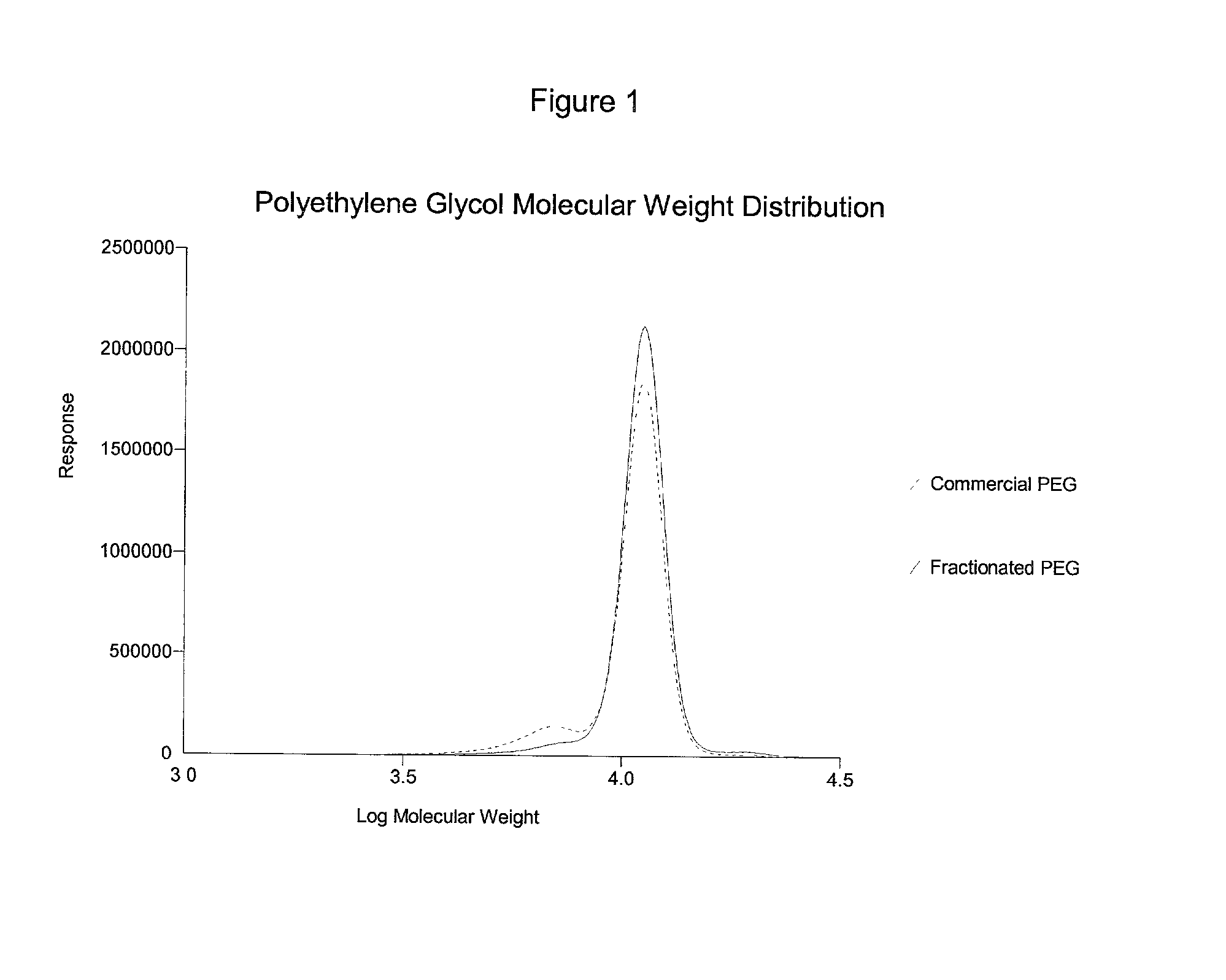Process for the fractionation of polymers
a technology of polymer and fractionation process, applied in the direction of solvent extraction, separation process, organic chemistry, etc., can solve the problems of high cost, complex equipment, and limited methods to organic materials
- Summary
- Abstract
- Description
- Claims
- Application Information
AI Technical Summary
Problems solved by technology
Method used
Image
Examples
example 2
[0063] Poloxamer 407 (lot number WPHT-543B), purchased from BASF Corporation, Mount Olive, N.J., was weighed and 486.0 g were dissolved in 15,733 g of deionized water. The solution was maintained at 0.1.degree. C. and 2335.1 g of (NH.sub.4).sub.2SO.sub.4 were added. The solution was equilibrated at 2.degree. C. and after two distinct phases formed, the lower phase was discarded, and the upper phase (2060 g) was collected and weighed. Deionized water (14159 g) was added and the solution was equilibrated to 2.degree. C. Next, 2171.6 g of (NH.sub.4).sub.2SO.sub.4 were added with stirring. After the salt was dissolved, the solution was maintained at approximately 2.degree. C. until two phases formed. The upper phase (3340 g) was isolated and diluted with 12879 g of deionized water. The solution was chilled to about 2.2.degree. C. and 2062 g of (NH.sub.4).sub.2SO.sub.4 were added. The phases were allowed to separate as above. The upper phase was isolated and extracted with 4 liters of di...
example 3
[0064] Poloxamer 188 (BASF Corp. Lot # WPMO-568B) was weighed and 4.5 g were dissolved in 145.5 g of deionized water. The solution was cooled to 2.degree. C. and 26.0 g (NH.sub.4).sub.2SO.sub.4 were added and dissolved with stirring. The solution was maintained at approximately 2.degree. C. until the phases separated. After two phases formed, the lower phase was discarded, and the upper phase was diluted with 125.4 g with deionized water. The solution was cooled to 0.3.degree. C. and 20.7 g of (NH.sub.4).sub.2SO.sub.4 were added slowly with stirring until the solution turned opaque. The solution was maintained at 3.degree. C. until two phases formed. After the phases separated, the upper phase was isolated and diluted with 125.4 g with deionized water, chilled to -0.4.degree. C. and 21.9 g of (NH.sub.4).sub.2SO.sub.4 were added to the solution and dissolved with stirring. The solution turned opaque, and was then maintained at 3.degree. C. until two clear phases formed. The lower pha...
example 4
[0066] Poloxamine 1307 (BASF Corp, Mount Olive, N.J., Tetronic 1307.RTM. Lot No. WPET-587B) was weighed and 0.45 g were dissolved in 15 g deionized water with stirring. The solution was chilled to 1.5.degree. C., and 2.28 g (NH.sub.4).sub.2SO.sub.4 were slowly added. The solution was maintained at 2.degree. C. until two phases formed. The lower phase was removed, 12.8 g of deionized water were added, and the solution was cooled to 0.6.degree. C. Next, 2.0 g (NH.sub.4).sub.2SO.sub.4 were added slowly with stirring. The solution was then maintained at 2.degree. C. without stirring until two phases formed. The lower phase was removed, 12.7 g of deionized water were added, and the solution was cooled to 1.4.degree. C. (NH.sub.4).sub.2SO.sub.4 (2.1 g) was added slowly, with stirring until the solution turned opaque. The solution was maintained at 2.degree. C. until two phases formed.
[0067] The upper phase was isolated and transferred to a separatory funnel with the addition of 30 ml of d...
PUM
| Property | Measurement | Unit |
|---|---|---|
| Percent by mass | aaaaa | aaaaa |
| Angle | aaaaa | aaaaa |
| Angle | aaaaa | aaaaa |
Abstract
Description
Claims
Application Information
 Login to View More
Login to View More - R&D
- Intellectual Property
- Life Sciences
- Materials
- Tech Scout
- Unparalleled Data Quality
- Higher Quality Content
- 60% Fewer Hallucinations
Browse by: Latest US Patents, China's latest patents, Technical Efficacy Thesaurus, Application Domain, Technology Topic, Popular Technical Reports.
© 2025 PatSnap. All rights reserved.Legal|Privacy policy|Modern Slavery Act Transparency Statement|Sitemap|About US| Contact US: help@patsnap.com



